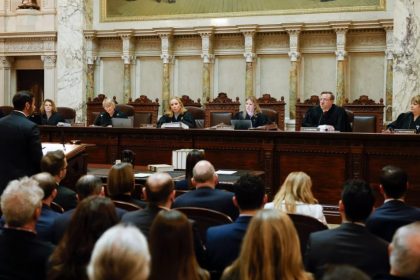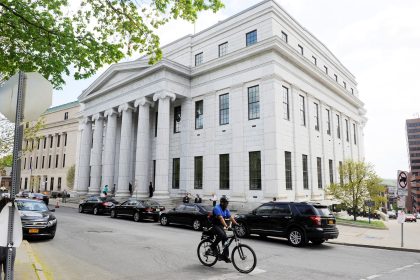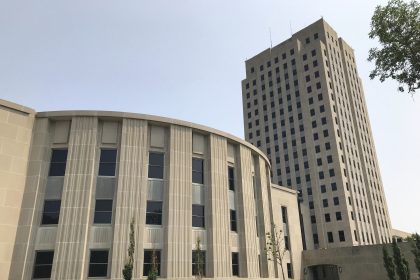New York’s Highest Court Tosses Congressional District Map

ALBANY, N.Y. — New York’s highest court ruled Wednesday that Democrats who oversaw the state’s redistricting process violated the state constitution and turned a blind eye to the will of the voters when they drew new congressional and state Senate district maps.
In a 32-page ruling accompanied by several dissents, a sharply divided New York Court of Appeals said the mapmakers acted as if a series of constitutional reforms passed by the state’s voters had “never been passed.”
“Through the 2014 amendments, the people of this state adopted substantial redistricting reforms aimed at ensuring that the starting point for redistricting legislation would be district lines proffered by a bipartisan commission following significant public participation, thereby ensuring each political party and all interested persons a voice in the composition of those lines,” Chief Judge Janet DiFiore wrote for the four-judge majority.
In addition, a majority of judges on the court found the congressional districts drawn by Democrats had violated an explicit state ban on partisan gerrymandering.
To remedy the situation, they ordered a court-appointed special master to draw replacement maps in time for use in this year’s midterm elections.
“In sum,” the majority said in a ruling that chided the state’s Democratic leaders on nearly every page, “there can be no question that the drafters of the 2014 constitutional amendments and the voters of this state intended compliance with the [Independent Redistricting Commission] process to be a constitutionally required precondition to the Legislature’s enactment of redistricting legislation.
“In urging this court to adopt their view that the IRC may abandon its constitutional mandate with no impact on the ultimate result and by contending that the Legislature may seize upon such inaction to bypass the IRC process and compose its own redistricting maps with impunity, the state respondents ask us to effectively nullify the 2014 amendments,” the judges said. “This we will not do. Indeed, such an approach would encourage partisans involved in the IRC process to avoid consensus, thereby permitting the Legislature to step in and create new maps merely by engineering a stalemate at any stage of the IRC process, or even by failing to appoint members or withholding funding from the IRC.”
The now void congressional map, which was adopted by Democratic supermajorities in February, reconfigured three Republican districts into new Democrat-friendly seats on Long Island, Staten Island and in central New York.
It also eliminated an upstate Republican district altogether. As a result, the map would have given Democrats an advantage in 22 of New York’s 26 congressional districts, compared with 19 seats currently held by Democrats and eight by Republicans.
To accommodate the drawing of new districts, the New York Court of Appeals said party primaries for the congressional and state Senate districts would have to be postponed from June until August.
The judges were silent on whether to move contests for governor and state assembly seats, as well, but they noted in the majority opinion that New York had held bifurcated primaries before.
“We are not convinced that we have no choice but to allow the 2022 primary election to proceed on unconstitutionally enacted and gerrymandered maps,” they wrote. “With judicial supervision and the support of a neutral expert designated a special master, there is sufficient time for the adoption of new district lines.
“Although it will likely be necessary to move the congressional and senate primary elections to August, New York routinely held a bifurcated primary until recently, with some primaries occurring as late as September,” they continued. “We are confident that, in consultation with the Board of Elections, [the] Supreme Court can swiftly develop a schedule to facilitate an August primary election, allowing time for the adoption of new constitutional maps, the dissemination of correct information to voters, the completion of the petitioning process, and compliance with federal voting laws, including the Uniformed and Overseas Citizens Absentee Voting Act.”
By the time the ruling concluded, the only map left standing was that for state general assembly districts, but that is apparently because no one thought to challenge them directly.
Most redistricting experts say the national congressional map that has grown out of each state’s redistricting efforts is nearly evenly divided between Democrat and Republican seats. Members of the national Democratic hierarchy had hoped the New York map would stand as a bulwark against modest Republican gains elsewhere.
New York is the most prominent state this cycle to have a new map tossed due to it being found overly partisan. Alabama, North Carolina and Ohio have also seen maps thrown out due to excessive partisan or racial gerrymandering by Republicans.
Meanwhile, in Maryland, a judge has ordered the redrawing of an “extreme gerrymander” that favored Democrats.
A congressional map adopted last week in Florida is the next expected to face intense legal scrutiny.
In dissent in the New York case, Justice Shirley Troutman, who was nominated to the court by former Gov. Andrew Cuomo, said she agreed with the majority on several points, most of them regarding the map-making process, but disagreed with its conclusion that the result was a partisan gerrymander and that a special master should be appointed to finish the job.
“Rather, the legislature should be ordered to adopt one of the IRC-approved plans on a strict timetable, with limited opportunity to make amendments thereto,” Troutman wrote.
“The remedy ordered by the majority takes the ultimate decision-making authority out of the hands of the legislature and entrusts it to a single trial court judge,” she said. “Moreover, it may ultimately subject the citizens of this State, for the next 10 years, to an electoral map created by an unelected individual, with no apparent ties to this State, whom our citizens never envisioned having such a profound effect on their democracy. That is simply not what the people voted for when they enacted the constitutional provision at issue.”
Justice Jenny Rivera, another Cuomo appointee, said she would reverse the majority’s opinion in its entirety believing the petitioners failed to establish the legislature violated the state’s redistricting procedures or constitutional mandates.
“The legislature acted within its authority by adopting the redistricting legislation challenged here after the Independent Redistricting Commission chose not to submit a redistricting plan by the second constitutional deadline,” Rivera wrote.
“Thus, there is no procedural error rendering the redistricting legislation void ab initio. Petitioners’ claim of a substantive violation based on gerrymandering is also without merit as their evidence fell far short of proving that the legislature’s congressional map was unconstitutional beyond a reasonable doubt,” she said.
Dan can be reached at [email protected] and at https://twitter.com/DanMcCue























